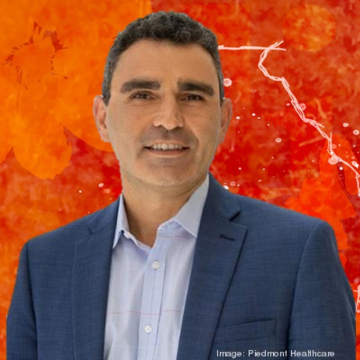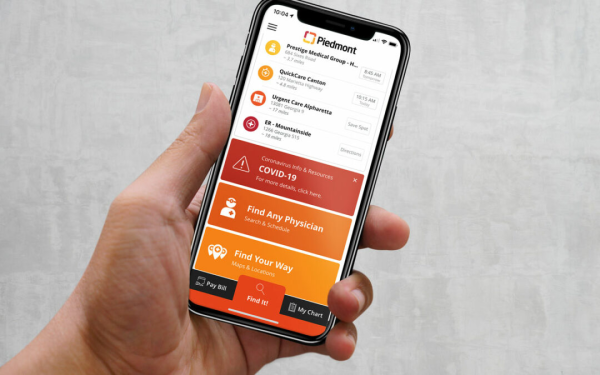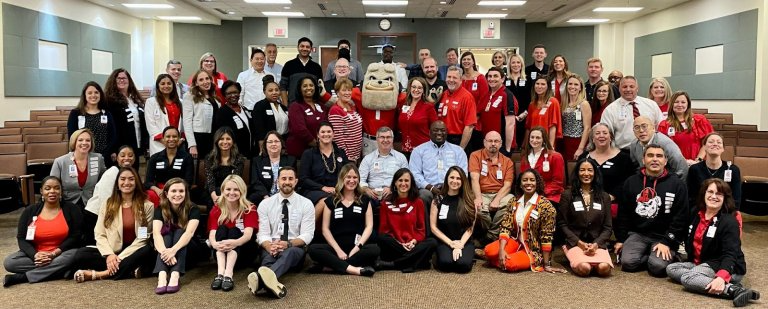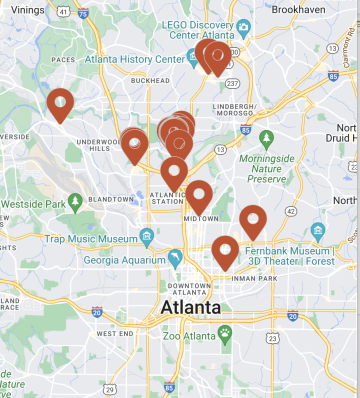
James Gardner, Director of Healthcare Strategy at OHO Interactive, recently spoke with Douwe Bergsma, Chief Marketing Officer at Piedmont, a highly respected health system in Georgia. Their conversation covered Douwe’s multifaceted career, the role of transformation management in brand growth, and the power of brand equity in healthcare. This marks the beginning of a series of articles celebrating the journeys, insights, and successes of select healthcare marketing leaders.
When I talk with healthcare brand leaders these days, it’s clear that more than ever, they’re playing the role of organizational change agents. One of the best examples is Chief Marketing Officer Douwe Bergsma, who leads brand growth at Georgia's Piedmont health system, overseeing internal and external communications, community education, consumer experience, digital innovation, physician outreach, and all other marketing functions.

Douwe, like me, began his career at Procter & Gamble. He spent nearly two decades at the leading consumer packaged goods company, starting with its first-ever cross-functional sales team in his native country of the Netherlands. “That was my first foray into transformation management, and I've been doing these kinds of things ever since,” he says. Douwe’s P&G successes include co-creating a shopper marketing capability for the organization and then overhauling the iconic Pringles brand, experiences that showed him the power of strong brand equity and retail relationships.
From there, Douwe moved to Georgia-Pacific, where he accelerated the company’s brand-building, digital, and e-commerce capabilities, a major win for an organization better known for its manufacturing and sales prowess. These experiences set the stage for his 2020 move to Piedmont. While healthcare wasn’t an obvious destination for Douwe, his consumer-focused background, desire to be a change agent, and strong leadership skills soon proved invaluable.
Douwe joined Piedmont in February 2020, just four weeks before COVID-19 began wreaking chaos on America’s healthcare system. At the same time, the not-for-profit community healthcare system was undergoing a massive growth and integration effort, growing from 11 hospitals when Douwe arrived to 23 today.

Balancing crisis response with learning a new industry, while working remotely, is a formidable challenge for any leader—even more so because Douwe’s scope of responsibilities had multiplied overnight. Piedmont is a $7 billion organization, with more than 44,000 team members, where brand growth touches nearly every aspect of operations.
“Probably a third of my role felt familiar,” Douwe recalls. “Internal communications, PR, community education, and physician outreach were new for me.”
Douwe’s rightfully proud of the collaborations he and Piedmont forged with other local health systems during the pandemic. This stretched budgets and ensured messaging consistency. “We divided and conquered,” Douwe explains. “We talked with them and said, ‘What are the messages we take, and which ones do you take?’ We used each other’s brand names and assets, so we could speak as one voice to the Georgia population.”
As many healthcare brand leaders know firsthand, providing steady leadership requires us to embrace these moments of uncertainty. While Piedmont’s COVID-19 response put major brand initiatives on the back burner, Douwe came out the other side eager to tackle new challenges.
At the same time, brand leadership in stability looks much different than brand leadership in crisis. This is evident in an organization’s culture and decision-making—particularly in healthcare, which tends to prioritize brand growth differently than, say, consumer packaged goods or retailing.
In the post-pandemic era, Douwe needed to cast a clear direction for his team. I wondered if he, like other CMOs I know, had identified a “North Star” to guide his thinking. His response hit multiple levels, starting with the Piedmont system as a whole.
“Since before I joined, our leadership has been driving our purpose of making a positive difference in every life we touch, specifically through clinical quality, patient experience, financial stewardship, talent development, and strategic growth,” Douwe notes. “That ‘Plan on a Page’ has been in place for years and continues to guide us today.”

This strategic direction translates to Piedmont’s operational priorities. “We want to be a healthcare system that drives access, integration, and easy navigation,” he continues. “Healthcare is not known to have a great consumer experience, outside the clinical interactions, compared with industries like airlines, retail, or hospitality. We want to close that gap by helping patients get access faster and better than anybody else. That involves a lot of digital infrastructure, cultural change, and process change, which was already in progress when I joined.”
This brings Douwe to his North Star over the past few years: doubling down on the Piedmont brand. “We had a lot of things in place that made us distinct from other healthcare systems, especially in terms of the patient experience,” Douwe notes. “We had a strong presence in the marketplace, with the most providers, the most locations, and the most patients. But we needed to find a brand proposition and positioning that made those benefits more clear.”
Through a comprehensive brand-building effort, Douwe and his team unearthed the big idea that would guide the brand’s evolution. “We landed on the concept that we empower Georgians by changing healthcare, making it more accessible, integrated, and easier to navigate. We’ve earned the right to say this since we're the only system that has had a presence in Georgia for over 200 years, and 80% of Georgians live within an hour of one of our 23 hospitals.”
 Chief Marketing Officer Douwe Bergsma and the Piedmont marketing organization
Chief Marketing Officer Douwe Bergsma and the Piedmont marketing organizationFrom there, Douwe’s team worked closely with their consumer experience colleagues, as well as with leaders across Piedmont’s sizable network of hospitals and clinics. “We think of this as brand building, brand activation, and brand orchestration,” he explains. “If our brand positioning is about empowering Georgians by making healthcare more accessible, integrated, and easy to navigate, we’d better deliver on all of those things.”
On a tactical level, that included hiring suppliers to boost Piedmont’s online presence, from collecting patient reviews and optimizing search to improving clinician bios and online appointment booking. “We’re leveraging email, which doesn’t really work for selling toilet paper, but is massive for Piedmont,” Douwe notes. “We improved the whole experience from the first point where you realize that you need healthcare service — from the moment you start looking for a medical oncologist, all the way to rating us on Google or Bing.”

For Piedmont, these efforts have helped to pull the levers of revenue growth. “When you make the brand stronger, driving revenue is easier,” Douwe notes. “We overhauled insights and analytics to understand what drives revenue, appointments, and procedures, and create attribution models that show the correlations to each of our activities. Adding to that, we have a strong partnership between finance, operations, and the physician enterprise, so we're all looking at the same data the same way.”
At this point in our conversation, I was buzzing with excitement about how far ahead of the curve Piedmont is—and has been for several years now. Starting under Katie Logan and Matt Gove — Douwe’s Chief Consumer and Strategic Planning Officer colleague and predecessor, respectively — Piedmont has led the industry with their famed “Piedmont Way,” an approach that focuses on the digital patient experience with a consumer-first mindset. By tying together brand, revenue, and patient experience, Piedmont is reaping the benefits of a truly integrated brand growth strategy.
Given the recent achievements at Piedmont, I was curious about what Douwe sees in the future of healthcare brand growth. While he’s clearly a proponent of technology, the first theme he mentioned was very human.
“The healthcare industry needs leaders who can bring creativity and confidence to the table,” he notes. “Most healthcare commercials are very similar. You see the doctor in a white coat in a new hospital, holding the patient’s shoulder, piano music playing in the background. But real creativity matters, and science has shown that it’s one of the highest drivers of ROI.”
While artificial intelligence can support creativity by automating some of the tedious parts of content development, Douwe says it’s key to set priorities first and then figure out how AI helps your organization solve those specific problems. Rather than asking “how to use AI,” Douwe suggests better questions may be, “How do you improve your CRM, email website, directory listings, online booking, and MyChart?” Each of these tools speaks directly to the patient experience, with a continued focus on making healthcare as seamless and user-friendly as possible.
Brand growth, and specifically employer branding, is also critical to solving healthcare’s talent shortage, Douwe stresses. “The one thing that I spend most of my time on, and that we're most concerned about, is talent for the system as a whole,” he explains. “How do we attract and retain nurses, lab technicians, cafeteria workers, and custodians? And how do I build the best-in-class brand growth team in healthcare and beyond? Talent has always been the secret sauce and the biggest challenge.”
Now more than ever, brand leaders are tasked with reshaping healthcare on a grand scale. In many ways, our job is to reinvent the way our organization interacts with patients at the most fundamental level. While many health systems recognize that healthcare consumerism is here to stay, we need concrete examples of how to shift to true patient-centricity. The Piedmont team is leading the way in this arena, and I can’t wait to watch their work unfold in the future.
(Thanks to Douwe and the Piedmont marketing team for their collaboration. I'll be profiling more healthcare marketing leaders in the coming weeks and months. If you'd like to be considered for the series, please contact me.)

 James Gardner
James Gardner
The original version of this page was published at: https://www.oho.com/blog/catalyzing-change-healthcare-brand-growth-leader-conversation-piedmonts-douwe-bergsma
OHO Interactive helps ambitious, forward-looking marketers maximize their investments in digital to elevate their organization’s prestige and recruit the customers they need.
Healthcare organizations and health insurers can implement an inbound content marketing strategy to improve brand recognition, attract new patients, and stay engaged with their current ...read more
What are the essential 2023 marketing, communications, and web conferences for hospital and health system marketers?Who doesn't enjoy attending healthcare marketing conferences? ...read more
Where will we see you in 2024? If you're a hospital or health system marketer, it's never too early to start making your conference plans! Who doesn't relish the opportunity ...read more
I’ve been thinking about Google Analytics 4 “migrations” all wrong.I knew we’d need to install the new pixel to start tracking. I knew I'd lose access to ...read more